Vinicunca, The Rainbow Mountain of 7 Colors.
@Asim Deb.
Common people call it The Rainbow Mountain because of its 7 distinct colors. At an elevation of 5,036 meters (16,522 ft.) above the sea level, geographically it is known by the locals as Vinicunca, or Winikunka, and also called by other names like, Montaña de Siete Colores (meaning Mountain of 7 colors), Montana de Colores (Mountain of colors) or Montaña Arcoiris (Rainbow Mountain). It is nestled majestically in the remote landscapes of the Andean Mountain range, of Peru, and it’s a geological wonder that has become a destination that sparks curiosity and admiration among adventurers and nature lovers alike. The mountain used to be covered by glacier caps, but these melted in 2013.
The 7 colors reflecting a true rainbow has been known to local communities for centuries, but it gained international popularity in 2015 when images and news about its stunning natural beauty spread. Today It has become one of the best tourist destinations in Peru. Recognized as a natural wonder, Vinicunca near the mountains of Cusco, is a key destination for tourists who also visit Machu Picchu. From Vinicunca mountain, people can enjoy an impressive view of the Ausangate glacier, a sacred mountain during the Inca Empire.
Vinicunca, originally a glacier, lies close to the ancient “Qolla Ñan” route, historically used by traders to shorten their journey from Puno to Paucartambo and by mountaineers on the Ausangate route. Due to deglaciation, the mountain’s exceptional colors in the soil, rocks, and minerals, formed 24 million years ago, have become visible now.

These 7 colors result from the sedimentation of materials like sandstone, halites, gravel, and limestone. Their chemical transformation through sulfation (** the formation of Sulfates or the process of adding sulfate groups to a molecule. It can occur in chemical reactions, biological systems) altered the pigmentation of the minerals. This geological formation is a product of the orogenic movements that created the Andes, displaying seven vivid colors:
Each color in this chromatic spectacle has a unique story:
• The delicate and subtle pink comes from red clay, mud, and sand.
• The pure and radiant white originates from substances rich in calcium carbonate, such as quartzite, sandstone, and marl.
• The intense and passionate red is composed of clays and shale.
• Meanwhile, the mysterious depth of the greens and blues comes from a combination of phyllite and clay rich in ferromagnesium.
• With its natural charm, the earthy brown originates in rocks and magnesium.
• And finally, the radiant and luminous yellow is a canvas of iron sulfide layers.
Red Valley
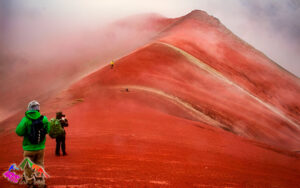
The Red Valley was discovered a few years ago and is located a few kilometers from the 7 Color Mountain and is the ideal complement for a visit to these two natural formations. Upon reaching the Red Valley, you shall a be part of nature and the beautiful landscapes that surround it, and with some luck, you might be able to come across lifestyle of the people who live in the areas near the Red Valley and also appreciate the presence of animals in the area.
Wildlife

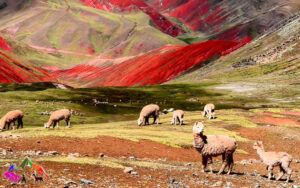

The fauna is a part of the ecosystem of Montaña de Colores due to its altitude where the Montaña Vinicunca is located, where Alpacas, Vicuñas, flocks of sheep, foxes, the Andean condor that makes a symbiosis exist in the Andes. These are rare species of animals we can find in the Southern parts of South American continent. They live mostly isolated from human habitats. The hunting of any specimen in this conservation area is strictly prohibited by the government for conservation and preservation of wildlife. Since these species are rare, thousands of nature loving people come here only to have closer views of the species.
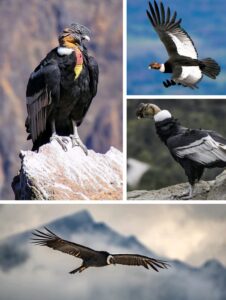
Describing the Andean Condor (Vulture gryphus) in a short note; it is a South American bird that belongs to the vulture family of Cathartidae and is the only living member of the genus Vulture. Although its numbers are dwindling in the country, the Andean Condor is the national animal of Colombia. Despite its enormous size, stunning plumage and fascinating behavioural traits, not many people know about this. With a wingspan of over 3 meters (10 feet), the Andean Condor is considered the largest flying bird in the world. Fully grown adults can reach a whopping 15 kg (33 pounds) and can stand an impressive 1.2 meters tall.
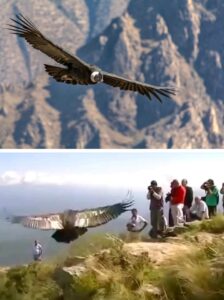
This stunning creature is the largest raptor in the world and a delight to see in the wild. Even with their impressive wingspan, they sometimes have a hard time staying aloft when in flight, due to their enormous weight. That is why this bird prefers windy areas, where it can glide effortlessly on the air currents. Andean Condors, with the help of mother nature, can soar up to a breathtaking height of 5,500 meters!
Rainbow Mountain History
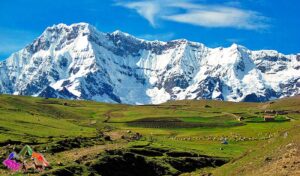
Rainbow Mountain remained hidden under glaciers and snow for many years, limiting its visibility and knowledge. In 2015, this natural gem of the rainbow mountains in Peru revealed itself to the world, shedding its old white cloak little by little due to the impact of climate change. Since then, it has become an unmissable destination for avid travelers seeking unique experiences and unforgettable glimpses. It’s no wonder that thousands of brave adventurers embark on the challenging hike to contemplate this geological wonder. Each step in the ascent promises wonders to discover, an opportunity to feel the strength and humility only nature can provide.

Origin of the Rainbow Mountain, Peru
The Rainbow Mountain owes its astonishing beauty to centuries of geological activity and changes in nature. The interaction of minerals and sediments over millions of years has created this breathtaking spectacle. Red clays, calcium carbonate-rich sediments, ferromagnesian compounds, and other combinations of elements interweave to paint an unimaginable color palette.
The Secret of the Andes Revealed
Rainbow Mountain used to be a challenging 15-kilometer hike. But a new route traced for tourist buses, the trek on foot has been considerably reduced, allowing us to admire this wonder in an exciting round trip of approximately 7 kilometers.
The Different Layers
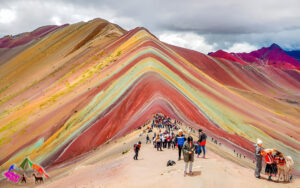
For Vinicunca, each color stands out distinctively as if painted by a supreme artist. But why is rainbow mountain Peru colorful? How were these dazzling hues formed?
The answer lies in an intricate geological dance, where volcanic activity and tectonic movements of the Nazca plates played a key role. Over millions of years, the minerals within were eroded and exposed by Mother Nature or Pachamama, revealing the wonder that now amazes both locals and visitors.
In November 2018, Peru’s President Martin Vizcarra ssued a decree enforcing a 12-month moratorium on all mining activity in the area. The Government stated wanted the region as a protected conservation area. In 2019, as a result of joint work between the Ministry of the Environment and the National Service of Natural Protected Areas (SERNANP), Ausangate was finally established as one of three new Regional Conservation Areas.


References:
https://www.perurail.com/blog-en/know-vinicunca-the-seven-color-mountain-of-cusco/
https://www.geologyin.com/2016/02/the-rainbow-mountains-in-peru-very.html
https://trexperienceperu.com/blog/vinicunca-rainbow-mountain
https://www.salkantaytrekking.com/blog/the-history-behind-the-rainbow-mountain-in-peru-vinicunca/
https://www.chimuadventures.com/en/blog/8-unusual-and-fun-facts-about-andean-condor
Wikipedia
********















Another gem in your collections, very well framed, written and presented with complete details. Your blog is getting richer and interesting with days passing.
Thank you, all the best and keep doing this good job for your passion and for your followers too.
Superb in one word.
Well written. Good collection. Lot of research work have been done.
As usual, yoy are great.
খুবই তথ্য মূলক লেখা। আমি রেনবো মাউণ্টেন এ যাই নি। নামও জানতাম না। ফিরে এসে যখন জানলাম তখন খুব আফসোস হলো। জানতাম না যে বরফে ঢাকা ছিল। ট্রেকিং করতে হয় তাও জানতাম না। এখন কমে গেছে তাও জানতাম না। Cusco আমি গেছি। ওর কাছে তা জানতাম না।
interesting part, কি করে rainbow কালারগুলো তৈরী হয়েছে।
Really, well written, and results of hard research work.
It’s a natural wonder of our Mother nature. She wears different dresses at different regions at different times. It’s one such wonder.
Myself was not aware of it, till I read this article.
We have to protect it from hungry tourists.
Such a majestic and extraordinary landscape of the mountain range is truly a geological wonder. Not surprisingly it is becoming a destination for curious nature lovers and adventurers.
It’s important that the region should be declared protected, more so because of its flora and fauna.
Truly an interesting article, and eye opener for nature lovers.
সংগ্রহে রাখার মত একটি লেখা। রেইনবো পাহাড়ের খুঁটিনাটি জেনে ভাল লাগল। বিশেষ করে, রেনবোর প্রতিটি রঙ কীভাবে হল জেনে সমৃদ্ধ হলাম।
Very well knit article, describing most of it: a little bit of history, the formation of different stone, and the environmental aspects.
I never knew about it, till reading this one. The article has been written in an interesting way.
Many thanks.
ঈশ্বরের এক অভিনব সৃষ্টি।
আমি এর আগে এই সাতরঙা পাহাড় নিয়ে কিছুই শুনিনি। আমার মনে হয় অনেকেই শোনেনি, কারণ সোস্যাল মিডিয়ায় এর খুব একটা উল্লেখ নেই। যে প্রাণীগুলির উল্লেখ করেছেন সেগুলিও বিলুপ্তপ্রায়, এর বিশেষ সংরক্ষণ প্রয়োজন।
প্রবন্ধটির খুব সুন্দর সহজ ভাষায় উপস্থাপনা করা হয়েছে, সকলেই বুঝতে পারবেন।
নমস্কার।
Awesome! What a surprise write-up from someone who has compiled interesting and authentic informations in his write-up. It has involved an enormous study of reference materials/documents to justify various aspects in the blog. I have gone through all details analysis connected with the Rainbow Mountain and Red Mountain. You have done a great job Mr. Asim Deb.
Asim,
You have done a great job.
Kudos to you.
An incisively researched article on rainbow mountains and its history. Enlightened reading it.
ছোটো থেকে জানা অজানা বিষয়ে আমার খুব আগ্রহ । সেই অনুসন্ধানে কিছু দিন আগে এই বিষয়ে জানতে পারলাম । এরপরে আপনার এত সুন্দর লেখা ….. অসাধারণ ….. আমি যত্নে সংগ্রহে রাখলাম ….. যদি ভ্রমণের সুযোগ হয় তাহলে তো এত ভালো তথ্য আর বোধ হয় কিছুতেই পাবো না…..
খুব ভালো লাগলো …..
Amazing, it is almost a research work with the description of geological features in painstaking details. Marvel at the amount of work involved. The article makes interesting reading, written with professional ease. The pictures are great though I expected a short description to accompany each picture.
I look forward to having many such quality articles in this blog
Enlightened, enjoyed reading
অসীমদা,
দারুন লিখেছেন। নতুন জিনিস জানলাম। আপনি কি পেরু গিয়েছিলেন ? অনেকটা ভ্রমণ কাহিনীর মতন লেখা। খুবই তথ্য- সমৃদ্ধ এবং সুখপাঠ্য।
Dada, this is marvellous. We knew about Andes mountain range of South America, but this beauty which you have so nicely penned in this article is a revelation. Rainbow mountain with it’s origin and scientific explanation makes this article more meaningful, particularly for students who are pursuing Geology, however for us it is a wonder. Once again, the photographs along with the article has added more significance, the fauna, the ecosystem embedded is added interest for globe trotters and tourists. Keep exploring. Best wishes.
Liked your subject of writing. Some thing different & new. Previously i read your writing on wine festival in Spain. This time about rainbow mountain in Peru. Probably Maya civilisation was established in this region. History apart it is a geographical marvel. Writing has become more interesting as you give photographs for relevant issue.
Though delighted to see rainbow mountain a pinch of pain felt deep in my heart. This mountain was covered by glaciers million of years & recently visualised after melting of ice due to climatic change. However, good to know Peru govt decided to preserve the site & no mining work will be allowed.
Heard of rainbow mountain earlier, but not in so much detail.
This precise but well written article is another informative and interesting reading, like others.
Kudos to your effort to collect information on so many different subjects and transform those into a lucid story.
অবিশ্বাস্য হলেও সত্যি।প্রকৃতির অনবদ্য সৃষ্টি।আমাদের কাছে সুন্দর ভাবে তুলে ধরার জন্য অসীম কে ধন্যবাদ জানাই।
অপেক্ষায় থাকবো আরো কিছু নতুন লেখার জন্য।
No, never heard of Rainbow mountain or Red mountain, either .
From my childhood days, Peru means Lima, Peru means Machchu Pichchu.
Used to think of visiting those places some day. Now, at the fag end of my life, it has become obvious that thise would remain in the list of unfulfillefd dreams, only albums and blogs are the consolations.
Asim’s blog is a source of joy for me.
The etharal beauty of both the mountains in the Andiz range of mkuntains, is breathtaking.
The scientific explanation on formation of various colour enlightens but out of my syllabi.
Narration and photographs have mesmerised me.
Thanks.
Asim’s blog is
Nicely written.
It’s another wonderful creation of the God. And now it’s the assignment for human community to maintain it.
Not so widely publicized in the media, hopefully the land and its flora fauna would sustain for long.
Let’s hope so.